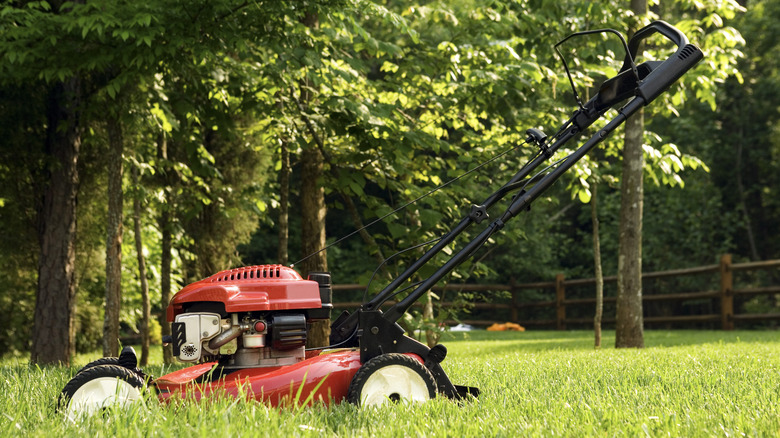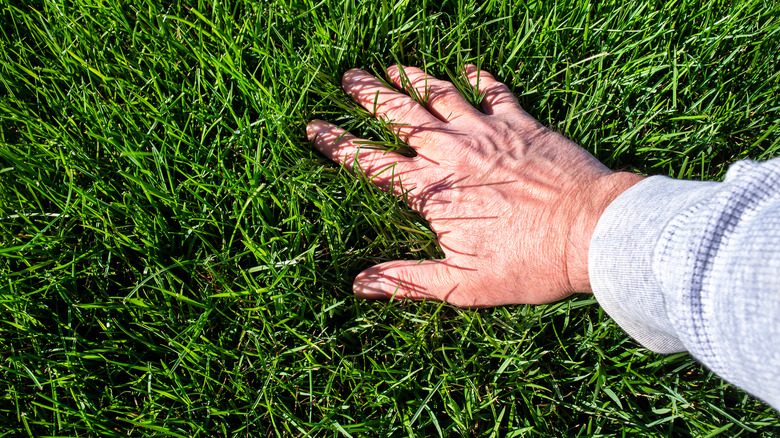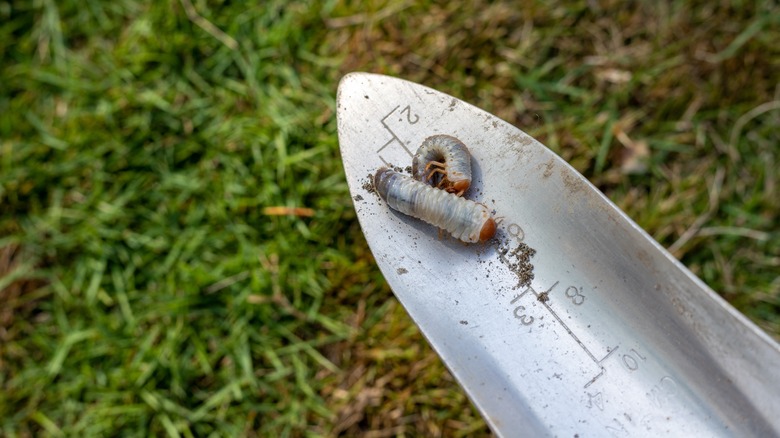Lawn Mowing Tips To Stop Grubs From Taking Over Your Yard
After carefully watering and trimming your lawn to utter perfection, there's nothing more disheartening than watching it turn from lush green to pale, yellow, and — eventually — into dead patches of grass. While there are a number of reasons this can occur, one of the most common causes is grub worms. Grub worms come from the eggs of Billbugs (June beetles) and when hatched, they eat at the crown of the grass plant and work their way into the soil, attacking the roots of your lawn. Although chemical and natural pesticide products are considered some of the best ways to get rid of grub worms, one of the easiest ways to prevent damage is to actually let the grass grow taller.
Because the grass has more surface area, that also means there's more opportunity for the blades to photosynthesize; a process where plants use sunlight for energy. Not only does this help to turn your lawn into that dreamy shade of green, but this also enables the plant to develop deep, healthy roots, which ends up being the key to minimizing the number of grub worms that live under the surface.
The best height to mow your lawn to minimize grub worms
Although taller grass may not seem as orderly and tidy as a closely trimmed lawn, longer grass means longer, stronger roots, making your lawn even more grub-resistant. Typically, adult female beetles are drawn to trim lawns to lay their eggs because the soil is moist and warm from the sun. However, cooler soil from taller blades could stave off the beetles and attract fewer pests, resulting in fewer grub worms. This is why experts recommend setting your lawn mower to the highest setting; about 3.25 to 4 inches in height to create a healthy, sustainable yard.
This is also why experts recommend overseeding, an all-natural tip that can help solve your lawn's grub worm problem. It not only enhances the appearance of your lawn, but it also crowds out space for those beetles to lay grub worm eggs, because they typically don't prefer those lush grassy environments. Plus, with very crowded roots, grub worms don't have enough room to feed, making it harder for them to dig into the dirt and take advantage of your gorgeous, lush lawn.
Why you should grow your grass tall and eliminate grub worms
Along with the dead spots on your lawn that are big eyesores, there are numerous other ways grub worms destroy your lawn. While it might be picturesque to lure songbirds to your yard to get rid of those pesky worms, grub worms attract other critters to your yard, such as possums, raccoons, and skunks. Grubs will also create loose, uneven turf from their feeding, as well as causing root damage. You'll have to tend to your lawn to make it even and plant new seed if you have a serious grub worm problem. But if you grow the grass out, this might not be something you'll have to worry about.
If you've ever considered participating in the "No Mow May" movement (which encourages homeowners to cease mowing their lawns for a month in order to grow flowers for pollinators), it might also be a great way to experiment with the way taller grass can benefit the health of your lawn overall. Besides becoming more grub resistant, tall blades of grass help to outcompete those pesky weeds, crowding them out. The longer blades create a shaded soil, which controls the excessive growth of weeds like broadleaf and crabgrass. Plus, the longer root system makes your lawn more drought tolerant. Experts even say that longer lawns don't need as many pesticides, if any at all, given how resilient the grass can be.



